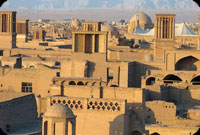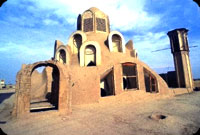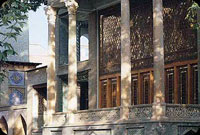
Wind
towers, Yazd
|
Wind
towers (Badgir) are important elements in traditional Iranian
architecture, providing natural air-conditioning in hot, dry and humid
climates for thousands of years.
These towers rise not only on ordinary houses but also on top of water
cisterns (Ab-anbar).
The function of the cistern found below most wind towers in warm dry
regions was to help balance humidity inside the structure.
In many desert buildings, wind towers were built on top of a lavabo (howzkhaneh,
which functioned as a summer courtyard). The wind was directed over the
pool where it evaporated the water and took the cool air into other
rooms.
The first historical evidence of wind towers in Iran dates back to the
fourth millennium BC.

Wind
towers, Yazd
|
To
counter the harshly variable climates of the country, Iranians invented
wind towers which still stand in various desert towns except in areas
where the city was located in a valley or in places experiencing
frequent violent storms.
Wind towers are an inseparable part of the architecture of central and
southern Iran, namely Yazd, Kashan, Bam and villages on the Persian Gulf
coast.
In desert areas houses are closely set together, high-walled and made of
baked brick with small windows facing away from the sun to minimize heat
and maximize shade.
In order to provide occupants with constant comfort, wind towers were
built with a four-directional orientation to catch wind from all
directions and guide it into the house.
Wind towers consist of four parts: the body containing shafts, air
shelves which catch hot air and prevent it from entering the structure,
flaps which redirect wind circulation, and a roof covering.
Wind travels through the shafts on top of the tower to reach the
interior of the building. The air flow inside the structure travels in
two directions, up and down.
The temperature difference between the interior and exterior of a
building causes pressure variations which results in the creation of air
currents.
In cities where the wind blows only from one single direction, only one
of the shafts operates to receive the breeze and the other three work as
air outlet passages.
There are three types of wind towers:

Water
reservoirs with 6 wind towers, Yazd
|
1- The
most elementary type of wind tower was built over cellars and
underground water reservoirs known as ab-anbar.
These cellars kept food refrigerated and also served as sitting rooms
where people could remain cool on hot summer days.
In hot climate cities, one to six wind towers were used to cool the
water. They prevented stagnant air and the formation of dew or humidity
inside, resulting in pure, clean and cold water all year round.
2- The second type transferred the flow into the basement where it hit
damp walls and its humidity increased while its temperature decreased.
The flow could be directed into other rooms using valves.
3- The third type of wind tower was taller and mainly used in
multi-roomed one-story buildings. A dome-roofed hall under the tower
helped ventilation.
Decorated with tiles or patterned or painted bricks, wind towers make
full use of the elements of Iranian architecture, prompting passers-by
to admire their beauty.

Wind
Tower Borujerdi House, Kashan
|
Among
the country's famous wind towers are the historical Borujerdi house's
tower and the Abbasian Badgir in Kashan.
The Dowlatabad garden wind tower in Yazd, presumably the world's
tallest, is said to be 250 years old and about 33 meters high. It is
surrounded by intricately hand-carved wooden lattice panels and stands
atop the Dowlatabad cistern.
Another noteworthy wind tower is the 26-meter tall Emarat-e Badgir (wind
tower monument) which is located in the eastern part of the compound of
Tehran's Golestan Palace, once the Qajar royal complex.
The tower, elaborately decorated with blue, yellow and black tiles, is
built on top of a lavabo (howzkhaneh).

Emarat-e
Badgir, Golestan Palace,Tehran'
|
Wind
towers display the compatibility of human-built architectural designs
with the natural environment and the ingenuity of Iranian engineers.
Following the introduction of western architecture, traditional
structures such as wind towers gradually became part of the past though
many still remain in use.
With today's growing emphasis on reducing energy consumption, modern
architecture can make use of traditional Iranian methods to utilize air
currents and evaporation in cooling and air-conditioning living
quarters.
|
 Wind towers, Yazd
Wind towers, Yazd Water reservoirs with 6 wind towers, Yazd
Water reservoirs with 6 wind towers, Yazd Wind Tower Borujerdi House, Kashan
Wind Tower Borujerdi House, Kashan Emarat-e Badgir, Golestan Palace,Tehran'
Emarat-e Badgir, Golestan Palace,Tehran'